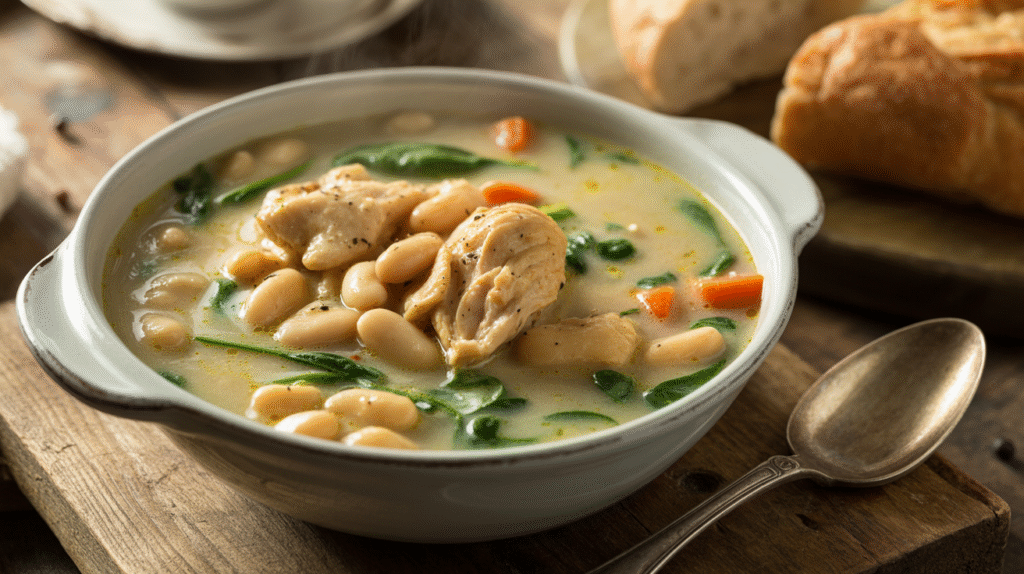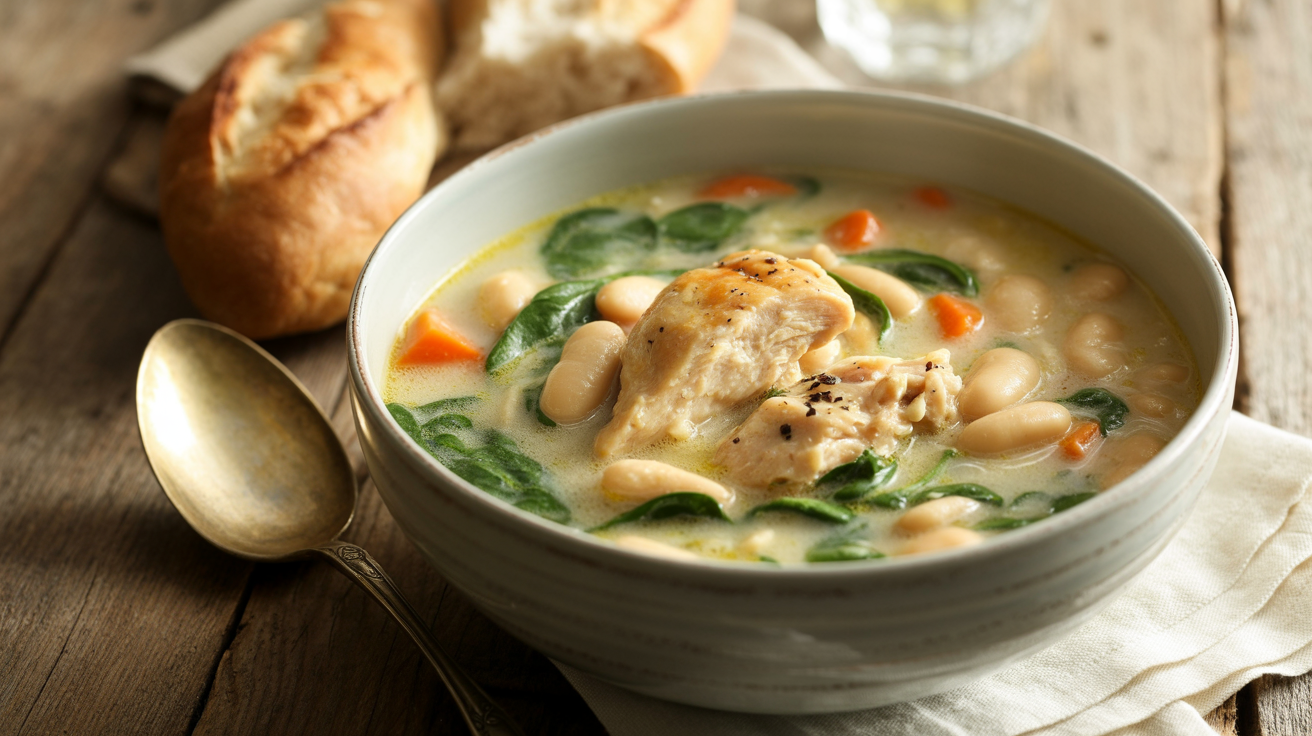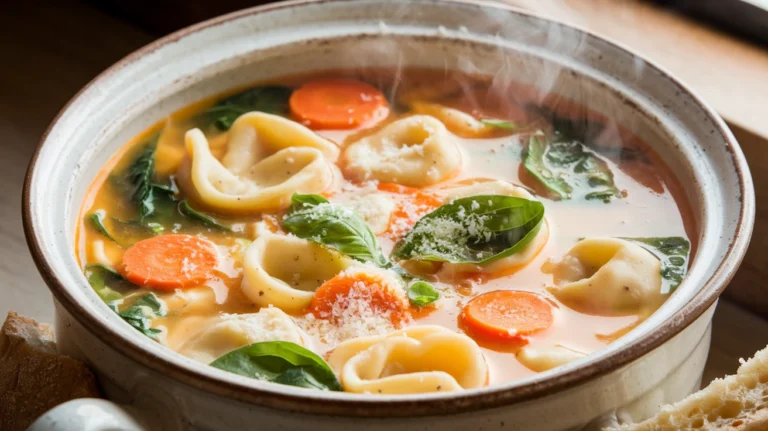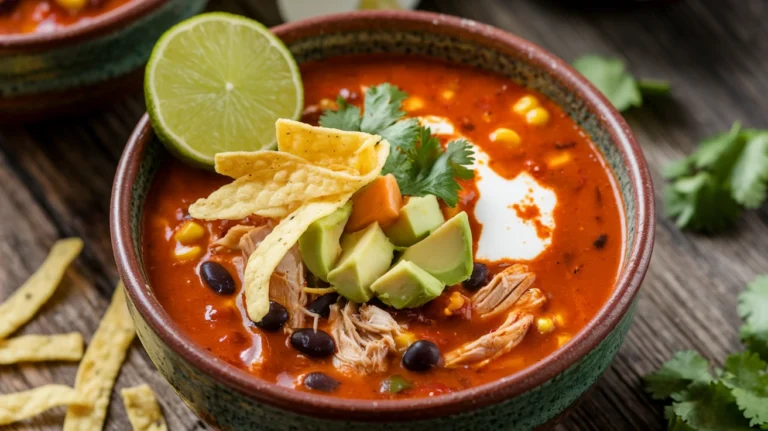This hearty tuscan chicken soup combines tender chicken thighs, creamy cannellini beans, and fresh spinach in a rich, aromatic broth that captures the essence of Italian countryside cooking. Our step-by-step tuscan chicken soup guide ensures even complete beginners can create this restaurant-quality dish that’s perfect for cozy family dinners and meal prep.
SERVES: 4 | PREP: 20 MIN | COOK: 25 MIN | TOTAL: 45 MIN
Ingredients for Perfect Tuscan Chicken Soup
Protein & Base
| Ingredient | Amount |
|---|---|
| Boneless, skinless chicken thighs | 1.5 lbs |
| Extra virgin olive oil | 3 tablespoons |
| Yellow onion, diced | 1 large |
| Carrots, sliced | 2 medium |
| Celery stalks, chopped | 2 stalks |
| Garlic cloves, minced | 4 cloves |
Flavor Builders
| Ingredient | Amount |
|---|---|
| Low-sodium chicken broth | 6 cups |
| Cannellini beans, drained & rinsed | 1 can (15 oz) |
| Diced tomatoes | 1 can (14.5 oz) |
| Heavy cream | 1/2 cup |
| Fresh baby spinach | 4 cups |
Seasonings
| Ingredient | Amount |
|---|---|
| Dried Italian seasoning | 2 teaspoons |
| Dried thyme | 1 teaspoon |
| Kosher salt | 1 teaspoon |
| Fresh black pepper | 1/2 teaspoon |
| Red pepper flakes | 1/4 teaspoon |
Detailed Step-by-Step Tuscan Chicken Soup Instructions
Phase 1: Preparation (8-10 minutes)
Step 1: Prepare Your Chicken Remove chicken thighs from refrigerator and place on a clean cutting board. Pat each piece completely dry with paper towels – this is crucial for proper browning. Using a sharp knife, trim any excess fat, leaving just a small amount for flavor. Cut chicken into uniform 1-inch cubes. Why this matters: Uniform pieces cook evenly, and dry chicken sears better, creating more flavor for your tuscan chicken soup.
Step 2: Season the Chicken Place chicken pieces in a medium bowl. Sprinkle 1/2 teaspoon salt and 1/4 teaspoon pepper over the chicken. Using clean hands or tongs, toss the chicken pieces until every surface is coated with seasoning. Let sit for 5 minutes while you prep vegetables. Beginner tip: Seasoning ahead allows the salt to penetrate the meat, enhancing flavor throughout.
Step 3: Prep Your Vegetables
- Onion: Peel and cut in half from top to bottom. Place flat side down and make horizontal cuts, then vertical cuts to create 1/4-inch dice.
- Carrots: Wash, peel, and slice into 1/4-inch thick rounds. Keep pieces uniform for even cooking.
- Celery: Wash stalks, trim ends, and chop into 1/4-inch pieces. Include some leaves for extra flavor.
- Garlic: Peel cloves and mince finely. Don’t prep garlic too early as it can become bitter.
Phase 2: Building the Flavor Base (12-15 minutes)
Step 4: Heat Your Pot Place a large Dutch oven or heavy-bottomed pot (at least 6-quart capacity) on your stove over medium-high heat. Allow it to heat for 2 minutes – you’ll know it’s ready when a drop of water sizzles immediately. Safety note: Never leave an empty pot heating unattended.
Step 5: Add Oil and Test Temperature Pour 3 tablespoons of olive oil into the heated pot. Swirl to coat the bottom evenly. The oil should shimmer and move easily but not smoke. If it smokes, reduce heat immediately. Visual cue: The oil is ready when it flows like water and has a slight shimmer on the surface.
Step 6: Sear the Chicken (First Batch) Working in batches to avoid overcrowding, carefully place half the seasoned chicken pieces in the hot oil. You should hear an immediate sizzle – this is good! Don’t move the chicken for 3-4 minutes. Why avoid moving: Moving too early prevents the golden-brown crust that adds incredible flavor to your tuscan chicken soup.
Step 7: Flip and Continue Searing Using tongs, check the bottom of one piece – it should be golden brown. Flip each piece and sear the other side for 3-4 minutes. The chicken doesn’t need to be fully cooked at this stage. Remove to a clean plate and repeat with remaining chicken. Temperature check: Internal temperature should reach 145°F at this stage.
Step 8: Capture the Fond Look at the bottom of your pot – you should see golden-brown bits stuck to the surface. This is called “fond” and it’s pure flavor gold. Don’t clean it off; we’ll use it later to enhance our tuscan chicken soup base.
Phase 3: Creating the Aromatic Foundation (8-10 minutes)
Step 9: Cook the Onions Add diced onions to the same pot with the leftover oil and fond. The onions will sizzle as they hit the hot surface. Stir frequently with a wooden spoon for 3-4 minutes. What to look for: Onions should become translucent and soft, not brown. If they’re browning too quickly, reduce heat to medium.
Step 10: Add Root Vegetables Add sliced carrots and chopped celery to the pot with the onions. Stir to combine and cook for 4-5 minutes, stirring occasionally. Texture check: Vegetables should start to soften but still have some firmness. They’ll continue cooking in the soup.
Step 11: Incorporate Garlic Add minced garlic to the vegetable mixture and stir constantly for 30-45 seconds until fragrant. Timing is critical: Garlic burns quickly and becomes bitter, so add it last among the aromatics and watch carefully.
Phase 4: Building the Tuscan Chicken Soup Broth (5-8 minutes)
Step 12: Deglaze the Pot Slowly pour 1 cup of chicken broth into the pot. As the liquid hits the hot surface, it will bubble vigorously. Using your wooden spoon, scrape the bottom of the pot to release all those flavorful browned bits. This step is crucial: These bits dissolve into the broth, creating the deep, rich flavor that makes homemade tuscan chicken soup superior to store-bought versions.
Step 13: Add Remaining Liquids Pour in the remaining 5 cups of chicken broth and the entire can of diced tomatoes with their juices. Stir to combine all ingredients. Quality tip: Use low-sodium broth so you can control the salt level in your finished soup.
Step 14: Season the Base Add Italian seasoning, thyme, and red pepper flakes to the pot. Stir well to distribute spices evenly. Increase heat to medium-high and bring the mixture to a gentle boil. You’ll know it’s ready: Small bubbles will form around the edges and occasionally break the surface.
Phase 5: Simmering to Perfection (15-18 minutes)
Step 15: Return Chicken to Pot Carefully add the seared chicken pieces back to the pot, including any juices that accumulated on the plate. Reduce heat to medium-low to maintain a gentle simmer. Visual guide: You should see small bubbles occasionally rising to the surface, not a rolling boil.
Step 16: First Simmer Phase Cover the pot partially (leave about 1 inch gap for steam to escape) and simmer for 8-10 minutes. Internal temperature check: Chicken should reach 165°F internal temperature. If you don’t have a thermometer, cut into the thickest piece – no pink should remain.
Step 17: Add the Beans Drain and rinse the cannellini beans in a colander under cold water. Add them to the simmering tuscan chicken soup and stir gently. Continue simmering uncovered for 3-4 minutes. Why rinse beans: Removes excess sodium and the thick liquid that can make soup cloudy.
Phase 6: Final Assembly (3-5 minutes)
Step 18: Temper the Cream Remove the pot from heat temporarily. In a small bowl, mix the heavy cream with 2 tablespoons of the hot soup broth. This prevents the cream from curdling when added to the hot soup. Temperature shock prevention: Never add cold cream directly to hot soup.
Step 19: Add Cream to Soup Slowly pour the tempered cream mixture into the soup while stirring gently. Return pot to low heat for 1-2 minutes to warm through. Don’t boil: Once cream is added, avoid high heat to prevent curdling.
Step 20: Incorporate Fresh Spinach Add fresh spinach leaves in handfuls, stirring after each addition until wilted. This takes about 1-2 minutes total. Fresh vs. frozen: Fresh spinach provides better texture and color in the finished tuscan chicken soup.
Step 21: Final Seasoning Taste your soup and adjust seasoning with salt and pepper as needed. Start with 1/4 teaspoon salt, stir, taste, and repeat until perfectly seasoned. Pro tip: The soup’s flavor will be more concentrated after cooling slightly.
Expert Chef’s Notes for Tuscan Chicken Soup Success
Chicken Thigh Advantage: Thighs remain tender and juicy in this tuscan chicken soup recipe, unlike chicken breasts which can become dry during the simmering process. The slightly higher fat content keeps the meat moist and flavorful.
Bean Preparation: Always drain and rinse canned beans to remove excess sodium and the starchy liquid that can make your soup cloudy. Cannellini beans hold their shape better than other varieties.
Cream Integration: The key to smooth, non-curdled cream in your tuscan chicken soup is temperature control. Always temper the cream and never let the soup boil after adding it.
Make-Ahead Magic: This soup tastes even better the next day as flavors meld. Store without the spinach and add fresh leaves when reheating for the best texture and color.
Nutrition Information (Per Serving)
- Calories: 385
- Protein: 32g
- Carbohydrates: 22g
- Fat: 18g
- Fiber: 6g
- Sodium: 890mg
Creative Tuscan Chicken Soup Variations
Hearty Kale Version: Replace spinach with 3 cups of chopped kale, adding it 5 minutes before the spinach would normally go in. Kale needs more time to become tender but adds incredible nutrition and a more robust flavor to your tuscan chicken soup.
Protein-Packed Option: Add 1/2 cup of cooked white rice or small pasta like ditalini during the last 5 minutes of cooking. This transforms your soup into a complete one-bowl meal.
Mediterranean Twist: Incorporate 1/4 cup of sun-dried tomatoes (chopped) and 2 tablespoons of capers with the regular tomatoes. This intensifies the Italian flavors and adds delightful briny notes that complement our bokchoy chicken soup techniques.
Spicy Tuscan Style: Double the red pepper flakes and add 1 teaspoon of smoked paprika for a warming kick that pairs beautifully with the creamy base, similar to the heat level in our chicken vegetable soup.
Storage & Reheating Your Tuscan Chicken Soup
Proper Refrigeration: Cool soup completely before transferring to airtight containers. Store for up to 4 days in the refrigerator. The flavors actually improve as they meld together overnight.
Freezer Guidelines: This tuscan chicken soup freezes beautifully for up to 3 months. Note that the cream may separate slightly upon thawing – simply stir vigorously or use an immersion blender to re-emulsify.
Reheating Method: Warm over medium-low heat, stirring frequently to prevent sticking. Add a splash of chicken broth if the soup has thickened during storage.
Make-Ahead Strategy: Prepare the soup through adding beans, then freeze. When ready to serve, thaw, reheat, and add cream and spinach for the freshest taste.

Troubleshooting Common Tuscan Chicken Soup Issues
Problem: Soup Too Thin Solution: Mix 2 tablespoons cornstarch with 3 tablespoons cold water to create a slurry. Stir into the simmering soup and cook for 2-3 minutes until thickened. Alternatively, simmer uncovered for 5-10 minutes to reduce and concentrate.
Problem: Cream Separated or Curdled Solution: Remove from heat immediately and whisk vigorously. If still separated, blend 1 cup of the soup and stir back in. Prevention is key – always temper cream and avoid high heat.
Problem: Chicken Overcooked and Tough Solution: For future batches, reduce simmering time and check internal temperature frequently. Overcooked chicken becomes stringy in soup.
Problem: Bland or Underseasoned Flavor Solution: Add salt gradually, 1/4 teaspoon at a time, tasting after each addition. Also ensure you properly scraped up the fond (browned bits) for maximum flavor development.
Problem: Vegetables Too Mushy Solution: Cut vegetables larger next time and add them in stages based on cooking time needed. Carrots take longest, spinach takes shortest.
Essential Equipment for Tuscan Chicken Soup
- Dutch oven or large heavy-bottomed pot (minimum 6-quart capacity for proper heat distribution)
- Sharp chef’s knife (8-10 inch for efficient vegetable prep)
- Stable cutting board (preferably separate ones for chicken and vegetables)
- Wooden spoon (won’t scratch your pot and handles heat well)
- Tongs (for safely turning chicken pieces)
- Ladle (for serving without mess)
- Measuring cups and spoons (accurate measurements ensure consistent results)
- Can opener (for beans and tomatoes)
- Fine-mesh strainer (for rinsing beans)
Organized Shopping List for Tuscan Chicken Soup
Meat Department
- 1.5 lbs boneless, skinless chicken thighs
Fresh Produce Section
- 1 large yellow onion
- 2 medium carrots
- 2 celery stalks
- 1 head fresh garlic
- 4 cups fresh baby spinach (or 5 oz bag)
Pantry/Canned Goods Aisle
- 6 cups low-sodium chicken broth
- 1 can (15 oz) cannellini beans
- 1 can (14.5 oz) diced tomatoes
- Extra virgin olive oil
- Italian seasoning blend
- Dried thyme
- Red pepper flakes
Dairy Section
- 1/2 cup heavy cream (or small carton)
Five Success Secrets for Perfect Tuscan Chicken Soup
- Master the Sear: Properly browning your chicken creates the flavor foundation that separates homemade tuscan chicken soup from ordinary versions. Don’t rush this step – good browning takes patience but delivers incredible results.
- Build Flavor in Layers: Add seasonings at different stages rather than all at once. This technique creates complex, multi-dimensional flavors that develop throughout the cooking process.
- Control Your Temperature: Maintain a gentle simmer, never a rolling boil. High heat makes chicken tough and can cause cream to separate in your finished tuscan chicken soup.
- Timing is Everything: Add delicate ingredients like spinach and cream at the very end to preserve their color, texture, and nutritional value. This attention to timing makes the difference between good and restaurant-quality soup.
- Taste and Adjust: The secret to exceptional tuscan chicken soup is proper seasoning throughout the cooking process. Taste frequently and adjust salt, pepper, and herbs as needed – trust your palate over rigid measurements.
This comprehensive tuscan chicken soup recipe delivers authentic Italian flavors with foolproof techniques that guarantee success every time. The combination of tender chicken, creamy beans, and fresh spinach creates a satisfying meal that’s perfect for weeknight dinners, meal prep, or special occasions. With these detailed instructions, even complete beginners can create a restaurant-quality tuscan chicken soup that’ll become a cherished family favorite.




